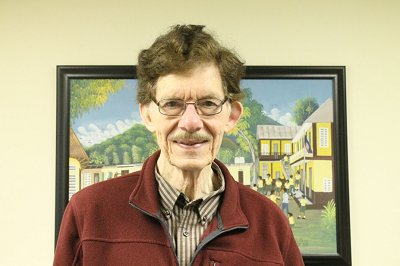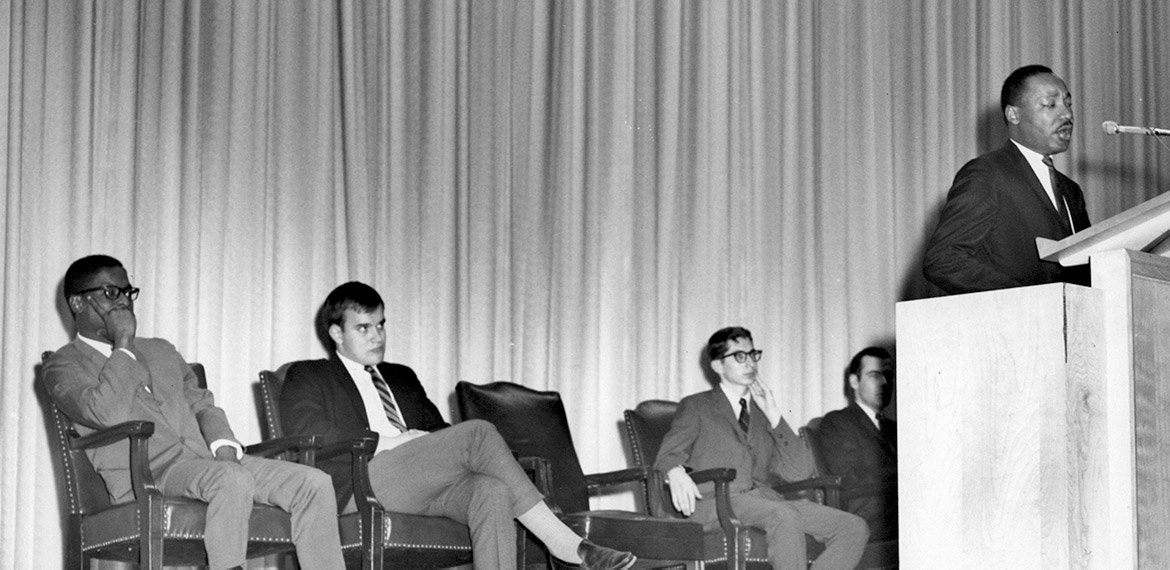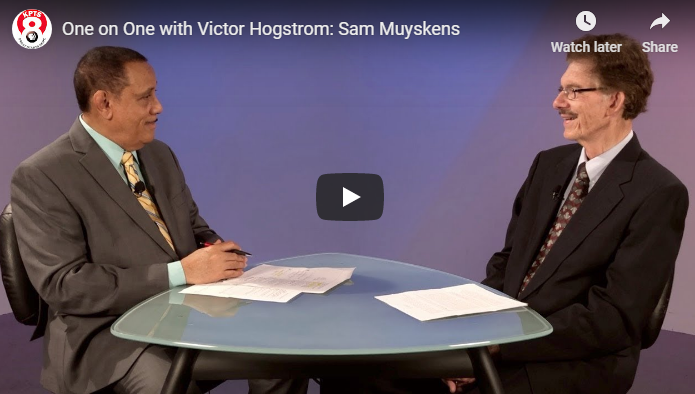A Handshake That Sparked Change: Meeting Dr. Martin Luther King Jr.
January 20, 2020

Written by: Amy Emerson
Last Friday, I had the privilege of interviewing Reverend Sam Muyskens, a Wichita man who listened to, met, and shook hands with Dr. Martin Luther King Jr. when he was a college student.
Muyskens is a United Methodist Minister and the founder and President of Global Faith In Action in Wichita. While attending a consultation with White House staff, he is quoted as saying, “Dialogue in action is more than sharing our beliefs, even more than being respectful of differing religious beliefs – it is relationship building, it is life changing.”
It was during the year that King visited Southern Methodist University that the college had its first black student — a football player by the name of Jerry LeVias. He was a talented athlete, but this did not stop the bullying he received for being darker skinned than the rest of the student body. The first week of football practice, a teammate jumped on LeVias’ back, cracked two ribs, and spit on his face. Even his white roommate moved out of their dorm room.
This is the story of Sam Muyskens, whose encounter with King sparked a passion to make a change.
The Day Muyskens Met King
23-year-old Sam Muyskens was one of the hundreds of college students gathered to listen as Dr. Martin Luther King Jr. gave a powerful — and in Muyskens’ case, life-changing — sermon on March 17, 1966.
The event at Southern Methodist University (SMU) was closed to the public, but to make room for all interested listeners in the overflowing 2,700 seat auditorium, every faculty member and student stood. Muyskens and a group of four friends had woken up extra early that day in order to ensure spots in the front row.
SMU student Bert Moore acted as King’s chauffeur from the airport and recalled a large crowd of white students and faculty being gathered on the steps outside the auditorium. He worried how they would react to King, but as soon as they got out of the car, “it was total silence.”
“I still kind of get chills,” Moore said. “We started walking up the steps and the crowd just parted — and started clapping.”
Charles Cox, Chair of the Students’ Association Academic Committee, introduced Dr. Martin Luther King Jr. to his packed audience. Though King was only given the title of his speech five minutes before he was scheduled to present, he spoke to the populous audience for 55 minutes.

(The people pictured behind Dr. King are (left to right): Bernard Lee, special assistant to Dr. King; Charles Cox, the chair of the Students' Association Academic Committee (now called the Student Senate); Bert Moore, vice president of the SMU Students' Association; and Sanford Coon, Perkins School of Theology student.)
“Throughout slavery, the Negro was treated in a very inhuman fashion,” King preached. “He was a thing to be used rather than a person to be respected. He was merely property subject to the dictates of his owner. Even religion was used, or I should say misused, to crystalize the patterns of the status quo and to justify the system of slavery.
“Then something happened to the Negro. The Negro came to feel that he was somebody. His religion revealed to him that God loves all of his children and that all men are made in his image and that the basic thing about a man is not his specificity but his fundamentalness, not the texture of his hair or the color of his skin but his eternal dignity and worth.
“Skin may differ, but affection dwells in black and white the same.”
As King’s speech concluded, Muyskens and his friends had an idea.
“We whispered to each other, ‘You know, when [King] leaves he’s going to go out that door,” Muyskens said. “‘Why don’t we go over by the steps and wait until he comes and see what happens?’ And so we waited, and sure enough Dr. Martin Luther King Jr. came out that very door.
“Oh I just wanted to shake his hand so badly — all of us wanted to — because we wanted to have a relationship with him, too. We liked what he had to say and we wanted to figure out what we could do to help.
“His body guards weren’t all that happy, but when he saw us, he was nothing but kind. He asked us questions about being students and what our futures held. We answered and as we were complimenting him, it was just beyond belief that we were standing there, right there — that he did come out the doors that we just guessed on and that he was encouraging us directly to help make a difference.
“I’ll never forget the last thing he did — we were all white students, by the way — he pointed right at us and said: ‘We need you. More than ever.’
After meeting King, Muyskens and his friends actively participated in non-violent sit-ins as well as civil rights marches to show support whenever they were held. Despite these regular efforts, Muyskens said he could not ignore how “tense” every event felt.
“It was so different then and now,” Muyskens explained. “We still have plenty of racism but the racism is different. We’ll work side by side with each other, but yet we don’t know each other. Instead, we’re just saying, ‘well, we’ve got to now, the law says we have to do it.’ We can invite each other, but until we really spend time with one another and try to understand each other’s thoughts, we’ll never really know each other.”
A Series of Sparks
In the summer months of Muyskens’ childhood, it was common for travelers to pass by his family’s house — after all, the train tracks were only two blocks away. Muyskens remembers how travelers would come and go for various reasons, but it seemed like they were always making a stop at his family’s house.
“A closed down water well with a working spout sat next to our house, so people in the community used to get their water that way,” Muyskens explained. “My mom would bring out food for the travelers — or as I called them, ‘hobos’ — and she’d sit there and visit with them. So one day I asked her, ‘How do they know to come to our house?’
“She pointed up to a tree outside and replied, ‘Well, just look up there — can’t you see the sign? It says “Anybody is welcome here.”’”
Muyskens said, “Well, I looked and looked and never could find the sign, but I understood what she was saying.
“I was really blessed to be brought up in that family. I was grateful to be taught the way I was, to be able to learn how to sing and play instruments, and to just experience as much as we did.”
Both of Muyskens’ parents were musical and taught their six children to play various instruments. Muyskens’ father, a pastor, even had a radio show that the family would record live performances for each week. The show’s theme sang, “In my heart there is a melody — a melody of love.” The dynamic family eventually formed the Muyskens Family Band and performed their music in all 48 contiguous states as well as Mexico and Canada.
During his first year of graduate school, Muyskens and his roommate decided to go to the airport to see Dr. Martin Luther King Jr. arrive from a distance. The two students watched him get off the plane, then carried on with their daily duties. Later that evening, they heard the radio announcement that King had been assassinated.
“I don’t know how you express it. I shared a handshake with a person that is beyond belief, and I will never forget the impact it has had on me,” Muyskens said.
The summer following King’s death, Muyskens was asked by a Presbyterian minister to help start worship caravans that would travel around the country. With his knowledge of music, newfound passion for bringing people together, and desire to help that was “burning up inside,” Muyskens accepted the challenge. One worship caravan led to another, and over several years the youth groups had traveled to cities all over the United States.
“It was very much a calling of people together and it was a powerful thing, too,” Muyskens said. “What I learned from all that was that we are all equal. Our United Methodist church was about 50 percent white people and 50 percent black people. We invited the youth, brought everyone together, and it was even more powerful because we traveled through the south. We’d stay at a campground to work for a few days, then go through the various places giving our position of, ‘We’ve got to become friends of all.’”
The most important lesson Muyskens has learned over the years, he said, is that building relationships is the only way to find peace.
“We’ve got to get the people together,” he said. “I will never truly know a person until we have some long time conversations or do things together. That’s what builds relationships.
“So that’s when it all started: with MLK, with the students that went [on the caravans], with helping them write their music and their liturgy. Those were some of the times that we were able to speak up and talk not only about what we were doing, but about what needed to happen with our country.”
Even though Muyskens only met King once, he said that meeting King had a different effect on him as a person. Since then, Muyskens has always worked on building true relationships — on gathering people together from different religious groups, colors, and backgrounds, and dialoguing together about issues that must be faced together.
“A poet named Sufi once wrote, ‘Beyond our differences, there is a field. I will meet you there,’” Muyskens added. “I believe that together we will find the field, and meet together in peace.”
.png)

